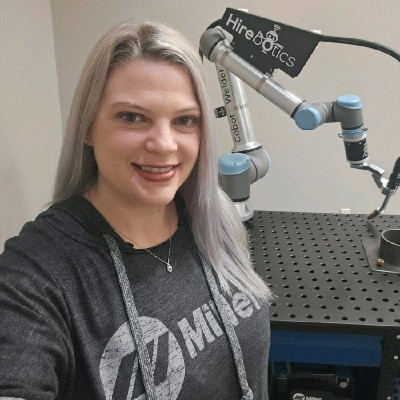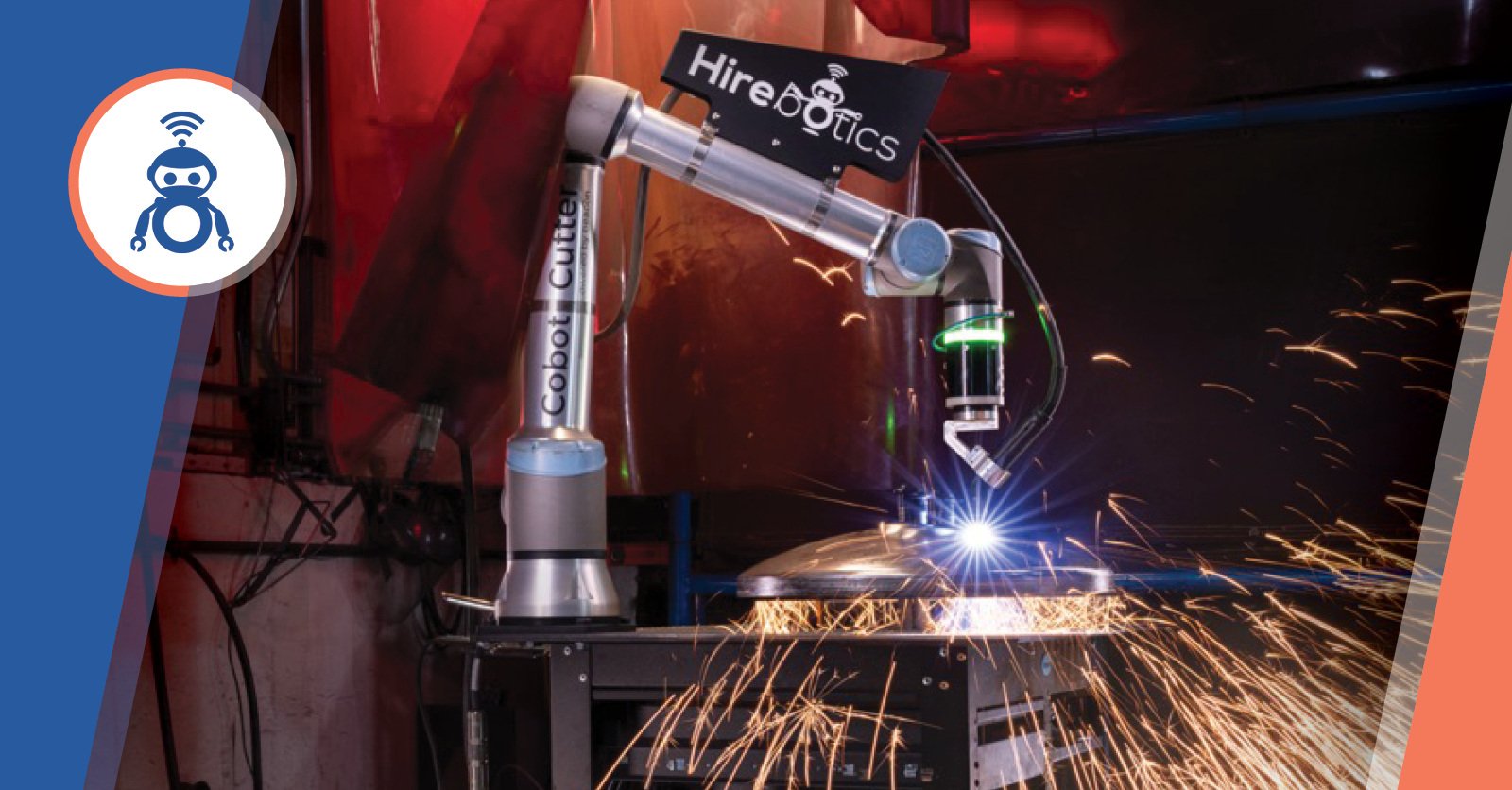4 Advantages & Disadvantages of Metal Plasma Cutting (That EVERY Fabricator Must Know)

May 10, 2024

If you’ve been in the metal fabrication industry for a while, you are no doubt familiar with the basics of plasma cutting. It uses a jet of ionized gas heated to over 20,000°C to make clean and precise cuts.
But is plasma cutting a good fit for your projects? Would investing in a cobot (collaborative robot) plasma cutter be worth the investment? And what should you consider before making such a purchase?
In this blog, we’ll walk you through pros and cons of metal plasma cutting. Whether you're thinking about adding this capability to your arsenal or just looking to step up your current setup, understanding these points will help you make the best decision.
Table of Content
- Advantages of Plasma Cutting
- Disadvantages of Plasma Cutting
- Why Plasma Cutting with a Cobot?
- Optimizing Your Fabrication with Hirebotics Cobot Cutter
Advantages of Plasma Cutting
Plasma cutting is known for its versatility and precision, making it a useful tool in the metal fabrication industry.
1. Versatility Across Various Metals
One of the key strengths of plasma cutting is its ability to efficiently cut various types of metals, including stainless steel and aluminum. This versatility is important if you work with a wide range of materials on different projects.
It's especially effective for medium-thickness materials, where it surpasses traditional methods like oxy-fuel in both speed and ease. This capability saves time and increases your shop's ability to handle a wide variety of projects.
2. Improved Precision and Quality of Cuts
Plasma cutting produces accurate cuts that are consistently clean and sharp, reducing the likelihood of jagged edges or irregularities. This precision is beneficial when you need to cut intricate patterns or detailed work is required, as it can follow complex contours with minimal deviation.
The cleaner cuts produced reduce the need for additional finishing processes, such as grinding or deburring. This saves time and minimizes the manual effort required to prepare pieces for welding or assembly.
Cleaner cuts also mean less material wastage and a smoother production flow, which helps maintain cost efficiency and meeting project timelines.
3. Lower Operation Costs
Plasma cutting offers several cost advantages, especially when you consider the quicker cutting times and reduced energy consumption compared to other methods like oxy-fuel.
- Quicker cutting time: Plasma cutting excels in speed, especially with thinner metals. For materials 1 inch thick or less, plasma can cut up to 2 times faster than oxy-fuel and as the material thickness decreases, the cutting speed increases. This speed advantage means you can complete jobs quicker, allowing for higher throughput and lower labor costs due to reduced machine and operator time.
- Energy and gas costs: While the initial setup cost for oxy-fuel might be lower, plasma cutting systems have lower ongoing operating costs. Plasma cutters mainly use electricity and compressed air, which are generally less expensive than the gases required for oxy-fuel cutting. This difference can add up over time, particularly in high-volume cutting environments.
4. Minimal Heat Exposure
Plasma cutting is also known for its minimal heat exposure, which maintains the integrity of the metal being cut. This is primarily due to the reduced heat-affected zone (HAZ) associated with plasma cutting.
- Reduced heat-affected zone: A smaller HAZ means that less of the material surrounding the cut is affected by thermal stress, which helps maintain the original properties and strength of the material.
By limiting the extent of the heat-affected zone, plasma cutting reduces the risk of material warping, distortion, and internal stresses that can arise from thermal expansion. This is ideal when working with precision components that require exact dimensional tolerances. - Dross production: Plasma cutting also offers dross-free cutting up to certain thicknesses. Beyond these thicknesses, while some dross is produced, it is typically easier to remove compared to other methods.
Minimal heat exposure and reduced dross are particularly important when creating intricate metal artworks, detailed mechanical parts for manufacturing machinery, or precision components for electronic devices. The ability to maintain the integrity of the material and ensure clean, precise cuts can significantly impact the overall quality and functionality of the final product.
Read More: Plasma Metal Cutting: What Fabricators Need to Know
Disadvantages of Plasma Cutting
While plasma cutting offers several significant advantages, it also comes with certain drawbacks that are important to consider. Let's discuss some of them and how the cobot cutter can help solve them.
Initial Investment Cost
One of the main disadvantages of plasma cutting is the initial investment required for the equipment. The cost varies depending on the system's capabilities, such as the power source, cutting speed, thickness handling, and whether it integrates advanced features like CNC technology.
The cost is not just limited to purchasing the machine. It also includes installation, setup, and the other necessary infrastructure to support the operation, such as adequate electrical supply and ventilation systems.
This initial cost can be a significant barrier to entry for smaller shops or startups that might not have the capital to invest in high-end equipment.
Using collaborative robots for plasma cutting helps mitigate the initial investment cost by offering a scalable and modular system that can be tailored to fit smaller budgets and expanded as business needs grow.
Skill and Training Requirements
Another challenge is the level of skill and training required to operate the machinery. While plasma cutters are not complex, they require specific knowledge and skills, especially for more sophisticated CNC plasma cutting systems.
Operators need to understand how to set up the machine, adjust settings like cutting speed and gas flow, and troubleshoot common issues. Training is crucial for achieving optimal cutting results and for ensuring safety during operation.
Read More: Improve Your Plasma Cutting Settings (with Cut Charts)
Many companies invest in certification or formal training programs to ensure their operators are well-versed in the nuances of plasma cutting. These programs cover topics such as machine operation, maintenance, safety protocols, and best practices for different materials and thicknesses.
A plasma-cutting cobot, like the Cobot Cutter simplifies this challenge significantly. It uses a user-friendly app to guide operators through the setup and operation process, eliminating the need for extensive training or deep technical knowledge. This makes it easier and faster for anyone on your team to start using the machine safely and efficiently, right from their smartphone or tablet.

Limitations in Thickness
While versatile and efficient for many applications, it does have limitations. Generally, plasma cutting is most effective for metal sheets up to about 50 mm (approximately 2 inches) thick. Beyond this thickness, the quality of the cut can degrade, with increased kerf width and more pronounced tapering effects.
For thicker materials, alternative cutting methods like oxy-fuel or waterjet cutting are often more suitable. Oxy-fuel can handle thicker materials, making it ideal for heavy industrial applications such as shipbuilding or large-scale construction projects.
Waterjet cutting does not have the heat-affected zone associated with plasma and can provide precision cuts on materials even thicker than what oxy-fuel can manage, though at a slower pace and typically higher cost.
While the Cobot Cutter doesn't handle extremely thick materials like a waterjet can, it excels in cutting steel alloys, aluminum, and stainless steel up to about 50 mm thick. It comes with guided settings to ensure you get the perfect cut every time, optimizing the plasma cutting process within its material thickness range.
Safety Concerns
Plasma cutting presents some environmental and safety challenges. The process generates excessive noise, intense light, and potentially harmful fumes and gases. These by-products can pose health and safety risks to operators and require proper mitigation strategies.
- Noise: Plasma cutting operations can be quite loud, with noise levels ranging between 90 to 120 decibels (dB). To put this in perspective, 85 dB is roughly as loud as a lawnmower and exposure to noise levels above 85 dB for prolonged periods can lead to hearing damage.
- Fumes and gases: The process produces fumes that can be hazardous if inhaled. Cutting areas need to be well-ventilated and have exhaust systems installed.
- Light and sparks: The intense light and sparks produced by plasma cutting is harmful to the eyes and skin. Protective eyewear with the appropriate filter shade and protective clothing should always be worn when operating this machine.
Proper training and safety equipment are investments that help mitigate these risks and ensure that plasma cutting remains a viable and safe option for metal fabrication.
A plasma-cutting cobot addresses safety concerns by automating some of the most hazardous aspects of plasma cutting. By reducing the need for manual operation, it lessens direct exposure to noise, intense light, and harmful fumes. Its user interface guides operators through proper setup and operation, promoting the use of correct safety measures and reducing the risk associated with human error.

Why Plasma Cutting with a Cobot?
Labor shortages in the fabrication industry continue to have a major impact on many operations, making it challenging to find skilled workers.
Cobots (collaborative robots) offer a modern solution that increases productivity, repeatability, and precision in environments where flexibility is important.
Plasma-cutting cobots are effective for handling a variety of parts and performing intricate cutting jobs with high precision. They are adaptable and can quickly switch between different materials or job types. Their adaptability makes them an ideal solution amidst workforce challenges.
Seamless Integration with Existing Systems
Hirebotics' Cobot Cutters are designed for easy integration into existing fabrication setups. Here’s how they shine:
- User-friendly interface: Operators can teach the cobot using just a smartphone or tablet app (Beacon), eliminating the need for deep robotics knowledge or programming skills.
- Unmatched support: Hirebotics provides real-time data monitoring and instant notifications through their cloud-based app, with support responses averaging just two minutes.
- Flexible and adaptable: Cobots can switch between different materials and cutting specifications, supported by intuitive software that guides operators through optimal cut settings.
Optimizing Your Fabrication with Hirebotics Cobot Cutter
Plasma cutting is an ideal choice for many fabrication shops. While requiring some initial setup and training, the long-term benefits, especially with the Hirebotics Cobot Cutter, are undeniable.
The Hirebotics Cobot Cutter brings versatility to your shop floor. It can be easily integrated with your existing setup and features an intuitive interface that simplifies training. You can manage everything through a smartphone or tablet, quickly getting your team up to speed.
If you want the precision that plasma cutting delivers, or you're facing challenges with labor shortages and want a boost in production, the Hirebotics Cobot Cutter is an excellent solution. It's designed to help you keep pace with industry demands and stay competitive.
Interested in seeing what the Cobot Cutter can do for you? Schedule a demo and see the impact it could have on your operations.



